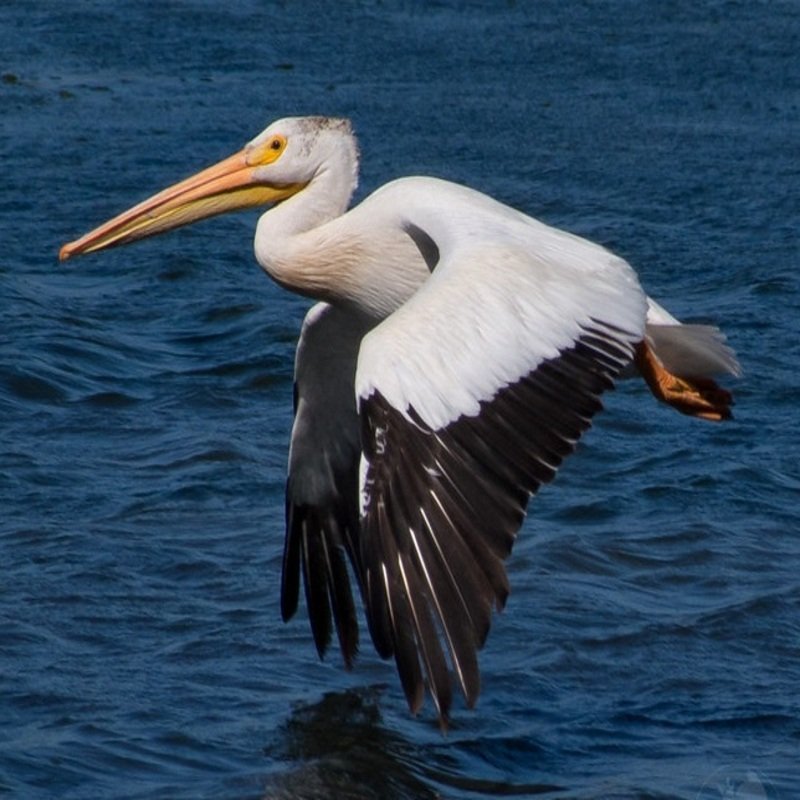Known as an American white pelican, Pelecanus erythrorhynchos is a Pelecaniformes big aquatic soaring bird. American white pelicans are the largest white pelicans in North America. It breeds in the interior of North America and winters on the coastlines of Central and South America.
Quick Overview: Pelecanus Erythrorhynchos – American White Pelican
Body size: Around 60-63 in (152-160 cm) and a weight of 6983 g (246.4 oz).
Main colors: White, Yellow, Orange, Black, Brown
Range: Throughout the United States
Migratory Bird: Yes
Best time of the year to see in the U.S.: January, February, June, July, August, September, December
Conservation Status: Least Concern
American White Pelican Description
American white pelicans are the largest white pelicans in North America. A black primary and outer secondary feather, a flesh-colored or yellow beak, and light yellow to brilliant orange legs. It’s a flattened protuberance on the top beak that both males and females grow during mating season. Brown pelicans are smaller and have a darker color. Males outnumber females. No subspecies or geographic variation is known.

Size
These birds have a length of 60-63 in (152-160 cm) and a weight of 6983 g (246.4 oz). Their wings could range from 96-110 in (244-279 cm).
Feeding
American white pelicans feed on fish, crabs, and amphibians. They may also feed in deeper waters near fish. During the mating season, they may graze at night. They hunt alone or in groups, dipping their bills into the water to gather prey into their bill and gular pouch. Foraging groups may work together to push prey into shallow waters, making capture more difficult.
Habitat
American white pelicans spend the winter in coastal bays and estuaries. The Salton Sea in California and big rivers where water movement avoids freezing are important wintering habitats. Island breeding on shallow inland lakes, rivers, and marshes. Islands can be permanent in freshwater or transitory in wetlands. It’s vital to know where birds breed and roost in order to plant breeding and wintering areas.
Behavior
Except for a few colonies in Mexico and the Gulf of Mexico, American white pelicans migrate yearly. Juveniles spend their first year in the winter range and begin yearly migrations at 2 years old. American white pelicans arrive on breeding grounds in early spring, generally by March or early April. A scattered fall migration They travel in huge flocks of approximately 180 individuals during the day.
Pelecanus erythrorhynchos Scientific Classification
- Kingdom: Animalia
- Phylum: Chordata
- Subphylum: Chelicerata
- Class: Aves
- Order: Pelecaniformes
- Family: Pelecanidae
- Genus: Pelecanus
- Species: Pelecanus erythro
Best time of the year to see
The best time to see these birds in the United States is during the winter season (December to February) and other parts are during the summer season (June- September).
Distribution of the American White Pelican in the USA
North American white pelicans are widespread. They breed on the inland prairies of the United States and Canada and winter along the coast. Breeding occurs in appropriate habitats from northern California, Nevada, and Colorado south to British Columbia. They winter in southern California, eastern Mexico, Texas, and the Gulf states, including Florida.
The American white pelican can be found in the following states in the United States – Alabama, Alaska, Arizona, Arkansas, Connecticut, Delaware, Georgia, Hawaii, Idaho, Illinois, Indiana, Iowa, Kansas, Kentucky, Louisiana, Maine, Maryland, Massachusetts, Michigan, Minnesota, Mississippi, Missouri, Montana, Nebraska, New Hampshire, New Jersey, New Mexico, New York, North Carolina, North Dakota, Ohio, Oklahoma, Oregon, Pennsylvania, Rhode Island, South Carolina, South Dakota, Tennessee, Utah, Vermont, Virginia, Washington, West Virginia, Wisconsin, and Wyoming.
